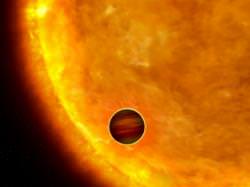The European Space Agency's COROT planet hunting observatory turned up its first planet - a hot Jupiter - surprising its managers at how quickly it would yield scientific results. COROT was launched in December, 2006, and it has only been making scientific observations for 60 days when it found a planet.
COROT discovers planets using the transit technique. It measures the total light emitted by a star very carefully, watching for a slight dip as a planet passes in front. Once several of these dips have been observed, the planet's size and orbital period can be calculated.
This newly discovered planet, now named COROT-Exo-1b, is a very hot gas giant, with roughly 1.78 times the mass of Jupiter. But unlike Jupiter, it orbits its parent star every 1.5 days. The planet is located about 1500 light-years from Earth in the constellation Monoceros.
Now that it's in orbit, scientists are getting a better sense of COROT's capabilities, and the news is really good. The recent observations show that it's much more sensitive than they had expected. Planets as small as the Earth should be detectable. And here's the great news, COROT should be able to detect the chemical composition of the planets' atmospheres. In other words, COROT will be able to detect the presence of oxygen and other signatures for life on Earth-sized worlds surrounding other stars.
The discovery of life on another planet may just be around the corner.
ESA News Release
 Universe Today
Universe Today
